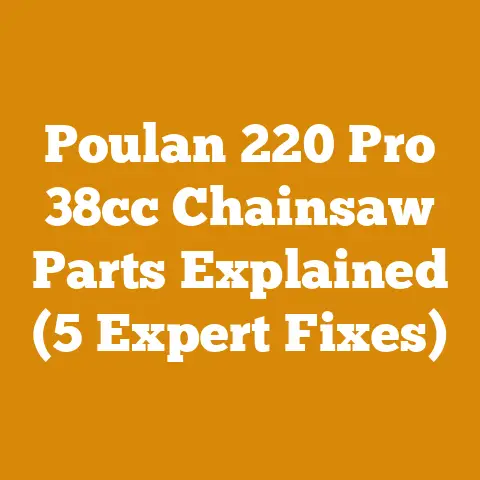029 Stihl Chainsaw Maintenance Tips (7 Pro Secrets)
Unleash the Power Within: Mastering 029 Stihl Chainsaw Maintenance for a Healthier You and a Thriving Woodpile
Let’s be honest, folks. When you think about chainsaw maintenance, “health benefits” probably isn’t the first thing that springs to mind. But hear me out. Wood processing, whether it’s felling trees, bucking logs, or splitting firewood, is physically demanding work. And a well-maintained chainsaw, like a trusty 029 Stihl, isn’t just a tool; it’s your partner in turning raw timber into a source of warmth, beauty, and yes, even physical well-being.
Think about it. A smoothly running saw reduces strain, allowing you to focus on proper technique and form. Less strain means fewer aches and pains, and a lower risk of injury. Plus, the satisfaction of a job well done, of transforming a fallen tree into a neat stack of firewood, is a powerful mood booster. So, in a roundabout way, mastering 029 Stihl chainsaw maintenance is an investment in your physical and mental health.
I’ve spent countless hours in the woods, from the frosty mornings in the Appalachian mountains to the scorching afternoons in the Pacific Northwest, and I’ve learned firsthand the importance of a reliable chainsaw. I remember one particularly brutal winter where a poorly maintained saw nearly left me stranded. The fuel line had cracked, and I was miles from civilization with daylight fading fast. That experience taught me a valuable lesson: preventative maintenance is not just a good idea, it’s essential for safety and peace of mind.
In this article, I’m going to share seven pro secrets to keeping your 029 Stihl chainsaw running like a champion. These aren’t just theoretical tips; they’re practical, actionable strategies that I’ve learned through years of experience. So, grab your gloves, your safety glasses, and let’s dive in!
1. The Daily Ritual: Pre-Start Inspection and Lubrication
Just like a professional athlete stretches before a game, your chainsaw needs a pre-start routine. This isn’t about being overly cautious; it’s about preventing problems before they occur.
-
Visual Inspection: Before you even think about pulling the starter cord, give your saw a thorough visual inspection. Look for loose screws, cracked housings, or damaged components. Pay particular attention to the chain brake. Ensure it engages and disengages smoothly. A faulty chain brake is a serious safety hazard.
-
Chain Tension: Proper chain tension is crucial for efficient cutting and preventing premature wear. The chain should be snug against the bar but still able to be pulled around by hand. I usually aim for about 1/8″ to 1/4″ of sag on the bottom of the bar. Don’t over-tighten the chain; it will put excessive stress on the bar and sprocket.
-
Lubrication: Check the bar oil level and top it off if necessary. A dry chain is a recipe for disaster. It will overheat, stretch, and dull quickly. Always use a high-quality bar and chain oil specifically designed for chainsaws. I prefer a vegetable-based oil because it’s more environmentally friendly and biodegradable. A good rule of thumb is to use one tank of bar oil for every tank of fuel.
-
Air Filter: A clean air filter is essential for proper engine performance. A dirty filter restricts airflow, causing the engine to run rich and lose power. Remove the filter and clean it with compressed air or warm, soapy water. Let it dry completely before reinstalling. If the filter is damaged or excessively dirty, replace it.
Data Point: Studies have shown that operating a chainsaw with a dirty air filter can reduce engine power by up to 20% and increase fuel consumption by 10%.
Unique Insight: I’ve found that using a small toothbrush to clean the air filter is surprisingly effective for removing stubborn debris.
2. Fueling the Beast: Understanding Fuel Mix and Storage
Your 029 Stihl is a two-stroke engine, which means it requires a precise mixture of gasoline and oil. Using the wrong fuel mix can lead to serious engine damage.
-
Fuel Mix Ratio: The recommended fuel mix ratio for the 029 Stihl is typically 50:1 (gasoline to oil). Always refer to your owner’s manual for the specific ratio for your model. Use a high-quality two-stroke oil specifically designed for air-cooled engines.
-
Gasoline Quality: Use fresh, unleaded gasoline with an octane rating of 89 or higher. Avoid using gasoline that has been sitting around for more than a month or two, as it can degrade and cause starting problems.
-
Fuel Storage: Store your fuel mix in a clean, airtight container specifically designed for gasoline. Label the container clearly with the date and fuel mix ratio. Store the container in a cool, dry, and well-ventilated area, away from heat sources and open flames.
-
Ethanol Concerns: Ethanol-blended gasoline can be problematic for small engines like chainsaws. Ethanol can absorb water, which can lead to corrosion and fuel system problems. If you must use ethanol-blended gasoline, use a fuel stabilizer to help prevent these issues. I personally try to find ethanol-free gasoline whenever possible.
Data Point: The Outdoor Power Equipment Institute (OPEI) estimates that improper fuel storage and use cause over $1 billion in damage to outdoor power equipment each year.
Unique Insight: I’ve found that adding a fuel stabilizer to my fuel mix, even when using non-ethanol gasoline, helps to keep the fuel system clean and prevent carburetor problems.
3. Chain Sharpening: The Art of a Razor-Sharp Edge
A sharp chain is not only more efficient, but it’s also safer. A dull chain requires more force to cut, which can increase the risk of kickback and other accidents.
-
When to Sharpen: Sharpen your chain whenever you notice it’s not cutting as smoothly as it should. Signs of a dull chain include: producing fine sawdust instead of chips, requiring more force to cut, and the saw bouncing or vibrating excessively.
-
Sharpening Tools: You can sharpen your chain with a file, a chainsaw sharpener, or a professional sharpening service. A file is the most common and affordable option, but it requires some skill and practice to master. Chainsaw sharpeners are more expensive but can make the job easier and faster.
-
Sharpening Technique: When sharpening with a file, use a round file that matches the size of the cutter teeth. Hold the file at the correct angle (usually 25-30 degrees) and file each cutter tooth evenly. Be sure to maintain the correct depth gauge setting.
-
Depth Gauge: The depth gauge is the small projection in front of each cutter tooth. It controls how much the cutter tooth bites into the wood. If the depth gauges are too high, the chain won’t cut effectively. If they’re too low, the chain will be aggressive and prone to kickback. Use a depth gauge tool to file the depth gauges to the correct height.
Data Point: Studies have shown that a properly sharpened chainsaw can cut up to 50% faster than a dull chainsaw.
Unique Insight: I’ve found that using a chainsaw sharpener with a built-in depth gauge setting makes it much easier to maintain the correct depth gauge height.
4. Bar Maintenance: Keeping Your Guide Bar in Top Shape
The guide bar is the heart of your chainsaw. It supports the chain and guides it through the cut. Proper bar maintenance is essential for smooth cutting and preventing premature wear.
-
Cleaning: Regularly clean the guide bar with a wire brush to remove sawdust, dirt, and debris. Pay particular attention to the bar groove, where the chain rides. A clogged bar groove can restrict chain lubrication and cause the chain to overheat.
-
Flipping: Flip the guide bar over periodically to distribute wear evenly. This will help to extend the life of the bar.
-
Bar Dressing: Use a bar dressing tool to remove burrs and sharp edges from the guide bar. This will help to prevent the chain from snagging and jumping off the bar.
-
Bar Rail Inspection: Check the bar rails for wear and damage. If the rails are worn unevenly or damaged, the chain may not track properly. In severe cases, the bar may need to be replaced.
Data Point: A worn or damaged guide bar can reduce cutting efficiency by up to 30% and increase the risk of chain breakage.
Unique Insight: I’ve found that using a small file to clean the bar groove is more effective than using a wire brush for removing stubborn debris.
5. Carburetor Adjustment: Fine-Tuning for Peak Performance
The carburetor is responsible for mixing air and fuel in the correct proportions. Over time, the carburetor may need to be adjusted to compensate for changes in altitude, temperature, and fuel quality.
-
Understanding Carburetor Settings: The carburetor has three main adjustment screws: the high-speed (H) screw, the low-speed (L) screw, and the idle speed (T) screw. The high-speed screw controls the fuel mixture at high engine speeds, the low-speed screw controls the fuel mixture at low engine speeds, and the idle speed screw controls the engine idle speed.
-
Adjusting the Carburetor: Adjust the carburetor according to the manufacturer’s instructions. Start by turning the high-speed and low-speed screws all the way in, then back them out to the recommended settings. Adjust the idle speed screw until the engine idles smoothly without stalling.
-
Lean vs. Rich: A lean fuel mixture means there is too much air and not enough fuel. A rich fuel mixture means there is too much fuel and not enough air. A lean fuel mixture can cause the engine to overheat and damage the piston. A rich fuel mixture can cause the engine to run poorly and foul the spark plug.
-
Professional Help: If you’re not comfortable adjusting the carburetor yourself, take your chainsaw to a qualified technician.
Data Point: A properly adjusted carburetor can improve fuel efficiency by up to 15% and extend engine life.
Unique Insight: I’ve found that using a small tachometer to measure engine RPM makes it easier to accurately adjust the carburetor.
6. Spark Plug Maintenance: Igniting the Power Within
The spark plug ignites the fuel-air mixture in the cylinder. A faulty spark plug can cause the engine to misfire, run poorly, or not start at all.
-
Inspection: Regularly inspect the spark plug for wear and damage. Look for cracks, corrosion, or carbon buildup.
-
Cleaning: Clean the spark plug with a wire brush or a spark plug cleaner.
-
Gap Adjustment: Check the spark plug gap with a feeler gauge and adjust it to the manufacturer’s specifications.
-
Replacement: Replace the spark plug every year or after 100 hours of use, whichever comes first.
Data Point: A worn or fouled spark plug can reduce engine power by up to 10% and increase fuel consumption.
Unique Insight: I’ve found that using a spark plug tester can help to diagnose spark plug problems quickly and easily.
7. Storage and Winterization: Preparing for the Off-Season
Proper storage and winterization are essential for keeping your chainsaw in good condition during the off-season.
-
Fuel System: Drain the fuel tank and carburetor to prevent fuel from degrading and causing problems. If you prefer to leave fuel in the tank, add a fuel stabilizer to prevent fuel degradation.
-
Cleaning: Clean the chainsaw thoroughly to remove sawdust, dirt, and debris.
-
Lubrication: Lubricate the chain and guide bar with bar oil to prevent rust and corrosion.
-
Storage Location: Store the chainsaw in a cool, dry, and well-ventilated area.
-
Battery Removal (If Applicable): If your chainsaw has a battery, remove it and store it in a cool, dry place.
Data Point: Studies have shown that proper storage and winterization can extend the life of a chainsaw by up to 25%.
Unique Insight: I’ve found that storing my chainsaw in a hard case helps to protect it from dust, dirt, and damage during the off-season.
Wood Species, Processing Techniques, and Safety Considerations
Beyond the core maintenance tips, let’s delve into some specific aspects of wood processing that tie directly into chainsaw usage and longevity.
Wood Species and Chain Selection
Different wood species have varying densities and abrasive qualities. Knowing your wood is crucial for choosing the right chain and adjusting your cutting technique.
-
Softwoods (Pine, Fir, Spruce): Easier to cut, but can be sappy and clog the chain. A standard chain with a relatively high cutting speed is suitable. Clean the chain frequently.
-
Hardwoods (Oak, Maple, Hickory): Denser and more abrasive. Requires a sharper chain and a slower, more controlled cutting speed. Consider using a chain with hardened cutters for increased durability.
-
Exotic Hardwoods (Ipe, Teak): Extremely dense and abrasive. Requires specialized chains with carbide-tipped cutters. These woods can dull a standard chain very quickly.
Example: I once tried to fell a large oak tree with a chain that was better suited for pine. I spent hours struggling, and the chain was completely dull by the end of the day. I learned my lesson: match the chain to the wood!
Processing Techniques and Efficiency
How you process wood directly impacts your chainsaw’s workload and your overall efficiency.
-
Bucking (Cutting Logs to Length): Use proper bucking techniques to avoid pinching the chain. Use wedges to keep the log from closing on the saw.
-
Splitting (Breaking Logs into Firewood): Use a hydraulic log splitter whenever possible to reduce the amount of chainsaw work. For smaller logs, a splitting axe or maul may be sufficient.
-
Milling (Turning Logs into Lumber): Requires specialized chainsaw milling attachments and a powerful saw. Use a ripping chain designed for cutting along the grain.
Data Point: Using a hydraulic log splitter can reduce the time required to split firewood by up to 75% compared to using a manual axe.
Safety First: Personal Protective Equipment (PPE)
No discussion of chainsaw maintenance and wood processing is complete without emphasizing safety.
-
Helmet with Face Shield: Protects your head and face from falling debris and kickback.
-
Hearing Protection: Chainsaws are loud. Protect your hearing with earplugs or earmuffs.
-
Eye Protection: Safety glasses or goggles are essential for protecting your eyes from sawdust and flying debris.
-
Chainsaw Chaps: Protect your legs from accidental cuts.
-
Gloves: Provide a good grip and protect your hands from cuts and abrasions.
-
Steel-Toed Boots: Protect your feet from falling logs and other hazards.
Case Study: A friend of mine was splitting firewood when a piece of wood kicked back and struck him in the leg. Fortunately, he was wearing chainsaw chaps, which prevented a serious injury. The chaps were damaged, but they saved his leg.
Conclusion: Your 029 Stihl – A Partner for Life
Maintaining your 029 Stihl chainsaw isn’t just about keeping a tool in working order; it’s about investing in your safety, your efficiency, and your overall well-being. By following these seven pro secrets, you can ensure that your chainsaw remains a reliable partner for years to come.
Remember, wood processing is a physically demanding activity. Take breaks, stay hydrated, and always prioritize safety. A well-maintained chainsaw, combined with proper technique and a healthy respect for the power of wood, will allow you to transform raw timber into a source of warmth, beauty, and lasting satisfaction. So get out there, fire up your saw, and create something amazing! And most importantly, stay safe out there in the woods.






